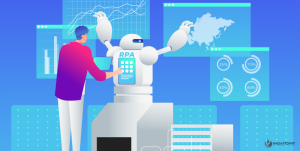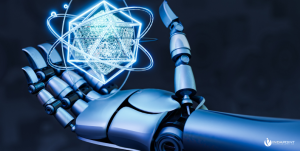Enterprises Deploying Generative AI at Scale: A Common Reference Architecture
July 2, 2025

Introduction
Generative AI (gen AI) has rapidly evolved from experimental technology to a core driver of business transformation. Enterprises across various industries are deploying generative AI models to automate processes, extract insights, and deliver personalized experiences at scale. However, realizing the full potential of gen AI requires more than just implementing powerful models—it demands a robust, scalable, and secure reference architecture that supports enterprise-grade requirements.
In this article, we’ll break down the typical reference architecture adopted by leading enterprises to deploy gen AI at scale. We’ll discuss its core components, real-world use cases, key benefits, challenges, and best practices for successful adoption.
Understanding the Gen AI Reference Architecture

Enterprises that succeed with gen AI deployments rely on a layered, modular reference architecture designed to meet the complex needs of business operations, security, and compliance. The reference architecture typically comprises four core components:
- A. Gen AI Platform Portal
- B. Gen AI Solution Automation
- C. Gen AI Shared Services
- D. Gen AI Governance and Guardrails
Each layer provides distinct capabilities, yet together, they form a cohesive ecosystem that supports scalable, responsible AI innovation.
Overview of Architecture Components

- Gen AI Platform Portal: Serves as the central “pane of glass” for monitoring, management, and stakeholder interaction.
- Gen AI Solution Automation: Automates deployment, integration, and operations, leveraging cloud infrastructure and DevSecOps best practices.
- Gen AI Shared Services provides essential services, including gateways, feedback, and compliance monitoring, to all deployed solutions.
- Gen AI Governance and Guardrails: Establishes controls for security, policy adherence, and responsible AI usage.
Component Deep Dive

A. Gen AI Platform Portal
The platform portal is the user interface for stakeholders, providing a unified environment for:
- Access solution catalogs and marketplaces
- Engage with chatbots, virtual experts, and Q&A bots
- Monitor deployed solutions through dashboards (metrics, documents, links)
- View documentation and manage AI learning resources
Enterprise Value:
This “single pane of glass” enables seamless onboarding, faster time-to-value, and transparent monitoring for business leaders, IT teams, and end users.
B. Gen AI Solution Automation
Automation is critical for maintaining security, scalability, and reliability. This component includes:
- Automated CI/CD pipelines for consistent deployments
- Control gates for compliance and quality assurance
- Infrastructure patterns that align with enterprise policies
Enterprise Value:
Solution automation ensures that gen AI applications are resilient, up-to-date, and compliant with regulatory requirements, reducing manual errors and operational overhead.
C. Gen AI Shared Services
Shared services provide a standard set of AI capabilities and controls, such as:
- Prompt libraries for faster solution development
- AI gateways for service management and monitoring
- Automated guardrails to detect bias, monitor feedback, and handle escalations
- LLM audit databases for transparency and accountability
Enterprise Value:
By centralizing shared services, organizations can standardize AI operations, enforce responsible use, and streamline maintenance across multiple business units.
D. Gen AI Governance and Guardrails
Strong governance is crucial for the responsible development of AI. This layer provides:
- End-to-end analytics, logging, and monitoring
- Private data management and security controls
- Lifecycle management and foundational model governance
- Policy adherence (e.g., ethical AI, FinOps, regulatory compliance)
Enterprise Value:
With governance and guardrails in place, enterprises reduce risk, maintain compliance, and ensure AI systems operate safely and ethically.
Real-World Enterprise Use Cases

Let’s examine how leading organizations across industries are leveraging this architecture:
Financial Services
- Fraud Detection: Utilise LLM-powered agents to analyze transaction data in real-time, flagging anomalies for investigation.
- Regulatory Compliance: Automated documentation and audit trails ensure adherence to complex financial regulations.
Healthcare
- Medical Record Summarisation: Gen AI models extract and summarise critical information from unstructured clinical notes, thereby improving efficiency and patient outcomes.
- AI-powered Chatbots: Provide 24/7 support to patients and healthcare providers for common queries and appointment scheduling.
Retail
- Personalized Recommendations: Utilise customer data and AI-generated insights to deliver highly customized product suggestions.
- Supply Chain Optimization: Predictive analytics models improve demand forecasting and inventory management.
Manufacturing
- Predictive Maintenance: Analyse sensor data using AI models to predict equipment failures and minimize downtime.
- Process Automation: Automate repetitive tasks, such as quality inspection and reporting, with AI-driven solutions.
Benefits and Challenges

Key Business Benefits
- Scalability: Supports hundreds of AI solutions across business units.
- Security and Compliance: Robust controls and governance ensure adherence to regulatory and ethical standards.
- Faster Innovation: Modular components enable teams to deploy and iterate on new use cases rapidly.
- Operational Efficiency: Automated workflows reduce manual intervention and errors.
Common Challenges
- Integration Complexity: Ensuring seamless connectivity between legacy systems and modern AI platforms.
- Data Management: Securing sensitive data and ensuring data quality for model training.
- Responsible AI: Managing bias, transparency, and accountability in AI-driven decisions.
- Change Management: Driving adoption across stakeholders with varying levels of AI maturity.
Best Practices for Enterprise Adoption

For CIOs, CTOs, and enterprise architects, successful gen AI deployment involves:
- Define Clear Objectives: Align AI initiatives with business strategy and measurable outcomes.
- Invest in Data Infrastructure: Ensure robust, secure, and high-quality data pipelines to support reliable data processing and analysis.
- Foster Cross-functional Collaboration: Bring together business, IT, and data science teams.
- Implement Strong Governance: Enforce ethical AI standards, compliance, and auditability.
- Prioritise Scalability and Flexibility: Select architectures that support growth and can adapt to new use cases.
- Monitor and Iterate: Continuously evaluate AI solutions for performance, fairness, and security to ensure optimal results.
Conclusion
As generative AI becomes integral to enterprise operations, adopting a typical reference architecture is essential for unlocking business value while maintaining control, compliance, and scalability. By leveraging a robust framework—comprising platform portals, automation, shared services, and governance—organizations can confidently deploy AI solutions that drive innovation and deliver measurable outcomes.




